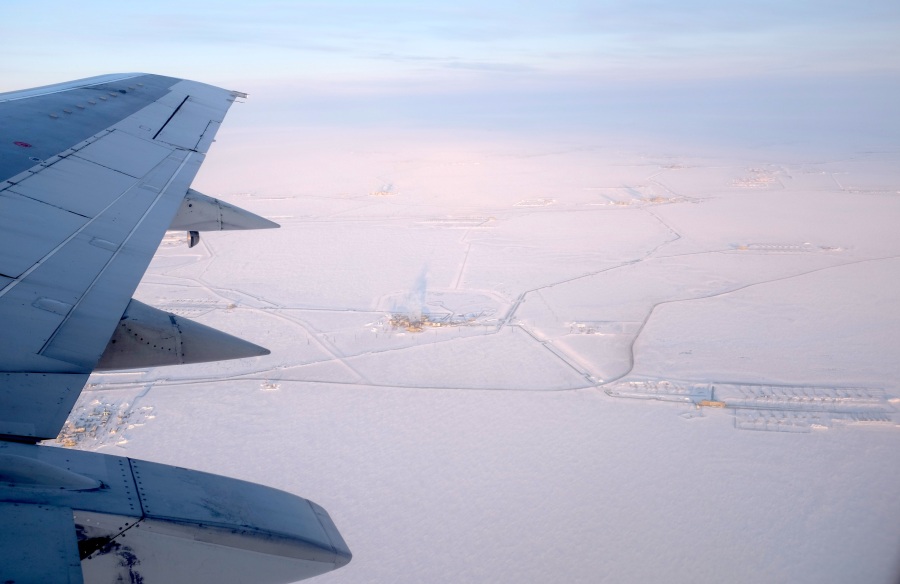Prudhoe Bay, Alaska. The place where polar bears butt heads with the petroleum industry – literally.
Prudhoe Bay, Alaska. The place where polar bears butt heads with the petroleum industry – literally. “If a bear’s spotted, work’s usually called off for the day,” a man in Barrow, 200 miles to the west, told me. Oil workers try to scare away the bear – sometimes a polar bear, sometimes a grizzly – and condition it so that it doesn’t come back in search of food.
On my recent trip to Alaska, I didn’t have the chance to stop in bear-battled Prudhoe or nearby Deadhorse, which houses the airport, lodging, and store for the oil workers. Deadhorse is also the end of the Dalton Highway, which starts north of Fairbanks some 400-odd miles to the south. I did, however, get to fly in and out of Prudhoe Bay airport, which in winter appears to miraculously emerge out of the white tundra.

Flying from Anchorage, our airplane soared over the Talkeetna Mountains and the Alaska Range. I dozed off soon after the snow-capped peaks transitioned into the relatively flat white plains of the Yukon-Tanana Uplands. When I woke up an hour later, the packed Alaska Airlines flight was descending into Deadhorse, laden with cargo for the winter construction season. The seats that would normally take up the front half of the airplane are replaced with a cargo hold on the airline’s 737-400 Combi planes. Winter is the big construction season in Prudhoe Bay because it’s the only time of year when the ground is solid and snow-covered. This permits driving on the tundra without permanently damaging it.

I looked at the view from my window seat and felt like we were descending onto another planet. It was a clear day and the sun bounced off the spindly network of chrome-colored pipes that criss-cross the North Slope. Straight, unwavering pipelines cut across meandering frozen rivers. All of the infrastructure out here is built on manmade gravel pads, for nothing can sit directly on top of the shifting permafrost, which thaws and refreezes every year. In this part of the world, gravel is almost more valuable than oil. The tiny rocks we take for granted down south are in short supply up north. No construction or excavation can happen without gravel.

The gray gravel pads are all but invisible in winter, however, and instead, the hundreds of miles of pipelines seem to stretch magically across the landscape. It is beautiful in its own way. Human ingenuity (or idiocy, depending on your point of view) has transformed an area that was once primarily used for local subsistence by the Inupiat people into a export-oriented resource frontier by dredging up the ancient seabed underlying the North Slope.
Prudhoe Bay is North America’s largest oil field. The extent of this industrial moonscape blew me away. It measures some 213,543 acres, or approximately 15 by 40 miles. That’s more than double the size of New York City and still significantly larger than Los Angeles. We flew over the oil field for a good long while before the platforms and pipelines faded into the west. Out here in mid-winter, it was impossible to tell where the tundra turned into the ocean, for both were frozen solid.

“In space we read time,” reflects German historian Karl Schlögel. Above Prudhoe Bay, I felt as if I was witnessing modernity in all its silver-plated excesses. The sight was all the more jarring having come from Anchorage, where I had wandered down the old main street and read about the bustling heydey of a past boom centered around the construction of the Alaska Railway. Faded murals and maps of the “Last Frontier” were the chief reminders of this wealthy era in the city’s history. Up in Prudhoe, what will this extreme edge of the rush for Alaska’s resources look like when the oil runs dry? Abandoned pipelines and platforms might then no longer epitomize a future-forward modernity, but rather a rusty past.


Hi Mia, Barrow is West of Deadhorse, not East. Otherwise, great article and photos.
Thanks for the catch, Bob!
other-worldly indeed!
When the oil runs dry, it’s mandated that all traces of the pipeline be removed.
Thanks for your comment, J. That may well be, but I think some degree of skepticism as to whether the pipeline will actually be removed is necessary given the history of companies leaving behind obsolete infrastructure once the resource has been depleted regardless of their obligations on paper.